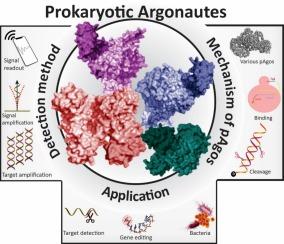可编程原核argonautas辅助食源性细菌敏感诊断的进展:功能和多路应用
IF 4.9
2区 化学
Q1 CHEMISTRY, ANALYTICAL
引用次数: 0
摘要
病原微生物引起的传染病在全球蔓延,对公共卫生构成重大挑战。因此,迫切需要开发敏感、选择性和用户友好的诊断技术,以有效控制这些感染的传播和发展。Argonaute系统被认为是一种先进的技术,已经成功地应用于广泛研究的CRISPR/Cas系统之外的生物传感应用。虽然CRISPR/Cas已被广泛探索,但其对PAM序列识别的依赖仍然相对有限。Argonaute因其作为靶活化核酸酶的作用和可编程性而被认可,正被重新用于开发新的传感技术。Argonaute凭借其设计的通用性、引导DNA的稳定性、多次转换活性的能力、优越的核酸裂解效率和高特异性,已被用于生物传感应用,从而开辟了分析化学的新领域。本文主要介绍了常见的Argonaute蛋白的工作机制和结构。本文概述了Argonaute与CRISPR/Cas系统相比在细菌分析中的优势。随后,argonaute衍生的病原细菌诊断传感方法进行了全面回顾,重点介绍了它们的设计原则。最后,对该领域的前景和当前面临的挑战进行了批判性的讨论。本文章由计算机程序翻译,如有差异,请以英文原文为准。

Advancements in Programmable prokaryotic Argonautes-assisted sensitive diagnosis of foodborne bacteria: functionalities and multiplexing applications
The global spread of infectious diseases caused by pathogenic microorganisms poses significant challenges to public health. Therefore, it is imperative to develop diagnostic techniques that are sensitive, selective, and user-friendly to effectively control the transmission and progression of these infections. The Argonaute system, recognized as an advanced technique, has been successfully employed in biosensing applications beyond the extensively studied CRISPR/Cas system. While CRISPR/Cas has been widely explored, its reliance on PAM sequence recognition remains relatively limited. Argonaute, recognized for its role as a target-activated nuclease and its programmability, is being repurposed to develop novel sensing techniques. By leveraging its design versatility, the stability of guide DNA, its capacity for multiple-turnover activity, superior nucleic acid cleavage efficiency, and high specificity, Argonaute has been employed in biosensing applications, thereby opening new horizons in analytical chemistry. This paper primarily presents the working mechanism and structure of common Argonaute proteins. The advantages of Argonaute compared to the CRISPR/Cas system in bacterial analysis are outlined and examined. Subsequently, Argonaute-derived sensing approaches for the diagnosis of pathogenic bacteria are comprehensively reviewed, with an emphasis on their design principles. Finally, the prospects and current challenges in this field are critically discussed.
求助全文
通过发布文献求助,成功后即可免费获取论文全文。
去求助
来源期刊

Microchemical Journal
化学-分析化学
CiteScore
8.70
自引率
8.30%
发文量
1131
审稿时长
1.9 months
期刊介绍:
The Microchemical Journal is a peer reviewed journal devoted to all aspects and phases of analytical chemistry and chemical analysis. The Microchemical Journal publishes articles which are at the forefront of modern analytical chemistry and cover innovations in the techniques to the finest possible limits. This includes fundamental aspects, instrumentation, new developments, innovative and novel methods and applications including environmental and clinical field.
Traditional classical analytical methods such as spectrophotometry and titrimetry as well as established instrumentation methods such as flame and graphite furnace atomic absorption spectrometry, gas chromatography, and modified glassy or carbon electrode electrochemical methods will be considered, provided they show significant improvements and novelty compared to the established methods.
 求助内容:
求助内容: 应助结果提醒方式:
应助结果提醒方式:


